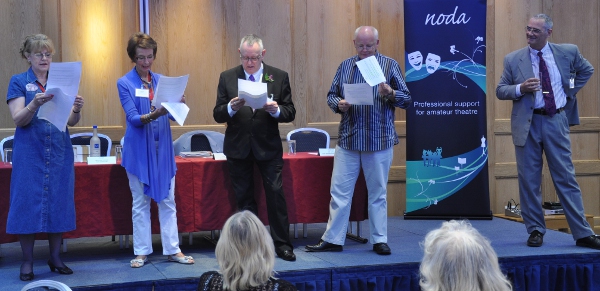This is going to be a rant about stage directions and seats, but I may take a while to get there because there are inconvenient corpses to dispose of, a siding of anomalous trains, and my dislike of the word preposition.
Verbs, nouns and adjectives are all defined by what they do – their grammatical function. Prepositions seem to be defined by where they go: they are positioned in front of an object. That, in itself, doesn’t tell me what they do. “They’re words that go in front of other words” isn’t much help, and it makes prepositions sound trivial. They’re not. In English in particular, prepositions do a lot of heavy lifting.
Having spent the entirety of my schooldays not studying Latin, I have recently dipped a toe into the language and found that Latin prepositions are comparative lightweights. Take the Latin word “in” for example. As a preposition, it tells you something about the relationship between the subject and the object that it preposes. Something, but not a lot. “In aqua” tells you that something is in the water, but “in aquam” tells you that something is going into the water. The preposition is the same, but here the case of the noun is doing the work to tell you the difference between the static state of being in the water and the dynamic plunge. Furthermore, the Romans thought that tables were like water: they would say “in aqua” to mean in the water, and “in mensa” to mean on the table. In Latin, the preposition tells you nothing about the nature of the object, whereas English prepositions not only tell you about the difference between a static relationship (in) and a dynamic one (into), but they also tell you something about the object, whether it is a container (in) or a surface (on). (In case you are wondering about water being a container, it is a container of fish and inconvenient corpses.)
There are some exceptions to the English use of “in” with a container and “on” with a surface. The ones that spring readily to mind concern public transport: I’m on the train. Why do we say that? If you want to specify the compartment of a train, you are in a carriage or in the buffet, never on, but we treat the complete entity of locomotive and carriages as a surface. I wonder if this is some sort of historical hangover from treating a means of land transportation as if it were a flat-bed cart (or a series of carts – a baggage train). That sort of origin is more likely with the evolution of road transport from wagon to bus. Less clear with the railways. A better idea might be the analogy with shipping, where one gets on board the ship because one steps onto the deck. (I suppose that’s true of busses as well, since they have single or double decks.) Anyway, I digress.
In most circumstances, “on” is used with surfaces. It doesn’t matter what the object is, as long as it behaves as a surface: you can have a book on the table or a picture on the wall. If you say “in the wall”, you are either referring to building fabric (another brick, or a hole) or it’s a very thick wall, and we’re back to the disposal of inconvenient corpses.
All of which brings me to chairs and some of the oddities that we have found whilst editing stage directions. You can sit on a chair, and you can sit in a chair, but they are different kinds of chairs. Some chairs are surfaces, some, generally softer and more comfortable ones, are containers. If a stage direction says that Mabel is sitting in a chair, the reader will recognise that the chair is a container and therefore probably imagine some sort of armchair. If Mabel is in a kitchen, sitting in a chair, the reader will wonder why there is an armchair in a kitchen. It is much more likely that Mabel is sitting on a kitchen chair. Similarly, nobody ever sat in a bar stool. You can save yourself work by letting the preposition do its job in the imagination of the reader, but if that creates an anomaly (and Mabel really is sitting in an armchair in the kitchen), then you need to add words to clarify.
 On or in?
On or in?
If you enjoyed this rant about stage directions and chairs, there is more joy for you in The Problem Of Bums on Seats.
If you came for the chairs, but stayed for the prepositions, then may I suggest ‘Why Can’t the English Teach Their Railways How to Speak‘?








